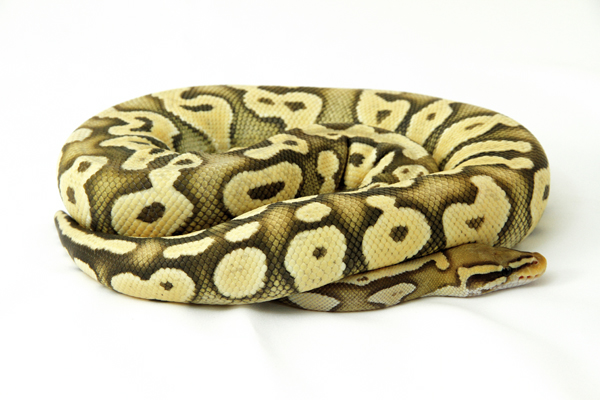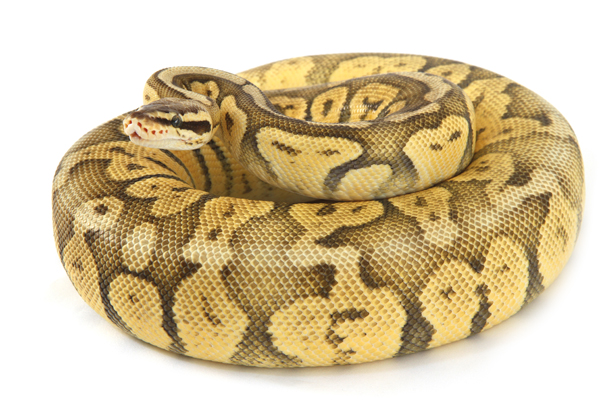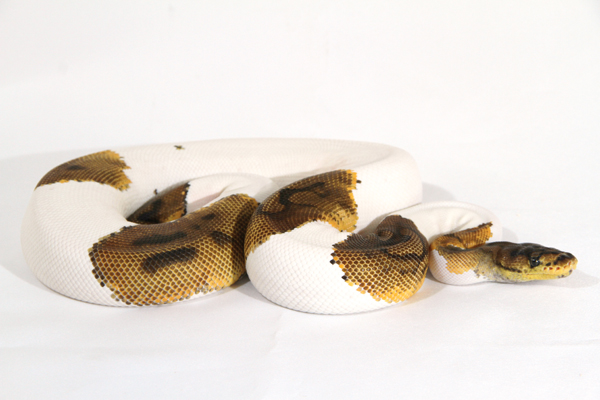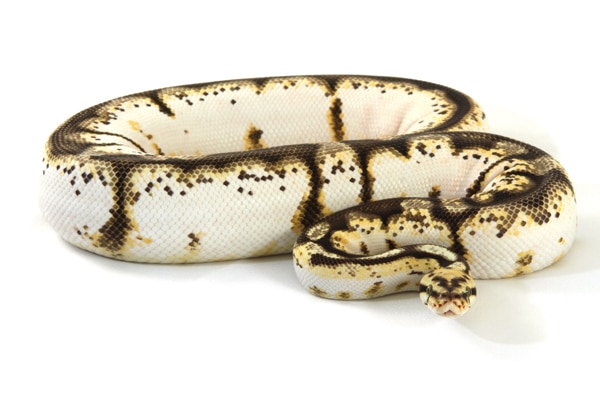About 40 years ago, the only ball pythons (Python regius) available for sale were imported, normally colored ball pythons from the countries of Ghana,
About 40 years ago, the only ball pythons (Python regius) available for sale were imported, normally colored ball pythons from the countries of Ghana, Togo and Benin. Many of these did not fare so well. Since those early days, tremendous advances have occurred in captive care and breeding. Today, tens of thousands of beautifully patterned and colored ball pythons are produced annually in the United States.
Read More
The ball python is native to western and west central Africa, and in its native range, ball pythons are often found living in grasslands and can even be found around farms. In grasslands, they commonly take refuge in abandoned termite mounds or rodent burrows. It is a relatively small python species, ranging from 3½ to 5 feet in length. Occasionally, an exceptional individual may reach a length of 6 feet, but this does not happen very often. With proper care in captivity, ball pythons can live for up to 40 years, and their docile nature, small size and the wide range of color and pattern choices make them excellent candidates for a pet.
Setup for Success
Before you purchase a ball python you need to determine the right kind of cage and equipment needed to properly house your future pet. There are many different types of cages on the market today. One of the most important things to consider when purchasing a cage is: Can it be securely closed? Snakes are escape artists, and the ball python is no exception. If there is any type of opening that they can get through, they will find it and get out! Another consideration is the area in which the cage is going to be placed in your home. If it is going to be kept in a cool basement, you may need to purchase a cage that offers better insulation. A ball python is able to live comfortably for its entire life in a 20-gallon long enclosure (30 inches long, 12 inches wide and 12 inches tall) or a 30-gallon breeder tank (measuring 36 inches long, 18 wide and 12 inches tall).
There are many different products on the market to choose from that can be used as a substrate. Reptile carpet is readily available and comes in a variety of lengths and widths. Make sure that you get at least two pieces. When one becomes soiled, it can be easily replaced with a clean piece. Take the soiled piece and clean it thoroughly, so it will be ready to use the next time the substrate becomes soiled. Aspen bedding is also a commonly used substrate. It is absorbent and easy to clean, and can be purchased as a shredded wood product or a chipped wood product. Some people even use newspaper to line their cages. This is inexpensive, and it is also quick to clean up. Avoid corn cob, alfalfa pellets, gravel and bark. These types of substrates can cause intestinal impaction if ingested. No matter which substrate you choose to use, it should be cleaned as soon as you notice that it has become soiled.

Colette Sutherland
Hypo pastel mojave morph.
Although any type of decoration for the cage is optional, a hide box is essential, as it provides a feeling of security to ball pythons. The box must be large enough for the snake to fit inside, but not too big. Ball pythons do better with a hide box that fits them just right. Sometimes, when ball pythons do not have an adequate hide box, they will try to use their water dish as one. This may lead to scale rot. Provide a sturdy water dish large enough for drinking but not soaking. Given that ball pythons are fairly strong, it is not hard for them to tip over a light-weight dish. Ceramic crocks are a good choice.
If the hide box or water dish become soiled, clean them thoroughly. This will help keep the enclosure from developing unpleasant odors and will provide your ball python with a healthy environment.
For décor, a large branch, though not necessary, will provide a surface for the ball python to crawl over and around. It may even offer a good surface to help the snake shed. If you choose to place anything from outdoors in your ball python’s enclosure, please make sure that the item is completely cleaned, sterilized and dry before placing it in your snake’s cage.
Ball pythons come from a fairly warm climate, so they need a good heat source. I avoid hot rocks, which may give a ball python severe burns. An undertank heat source is best. Please follow the instructions carefully to make sure that the undertank heater is properly and safely installed. There also needs to be a rheostat or another way to adjust the heat. Rheostats allow you to control and adjust the temperature to compensate for seasonal fluctuations in your home environment. The undertank heater should cover from one-fourth to one-third of the tank bottom, and it should be placed beneath one end of the cage, preferably near the hide box. It is important to remember that the cage’s ambient air temperature will not be the same as the temperature of the glass, or wood, directly above the heat source. Check the temperature directly above the hotspot. It should not exceed 88 degrees Fahrenheit. The ambient air temperature can be between 75 and 85 degrees, and it is okay for it to fluctuate. This is generally measured by placing a temperature gauge on the glass at the cooler end of the tank.
Please make sure that you reduce the risk of fire by not overloading outlets. If needed, use a power-strip. Given that ball pythons are primarily active at night, they do not require ultraviolet lighting. The natural light that comes into the room will be sufficient. It is not a good idea to place the cage in the path of direct sunlight, as heat can build up quickly inside the cage and may prove fatal to your pet. If the cage is going to be placed in a room that does not have natural light, it will be necessary to provide a light on a timer to provide the ball python with a day-and-night cycle.
Select the Best Python
Now that everything is ready, it is time to find the ball python of your dreams. With more than 2,500 different color and pattern variations to choose from, it can be a potentially daunting task. Fortunately, there are many breeders who offer photos of the exact animals that they have for sale. This allows you to take a good look at what they have to offer and will also allow you to choose the one that best fits your budget.

Colette Sutherland
Super pastel morph.
Before you purchase online, make sure that you do your research on the person offering the snake for sale. The reptile industry is not immune to scam artists, and more than one person has sent money off for something that has never arrived, or even existed.
Another concern that you may have is if you should buy a hatchling or an older ball python. Hatchlings are generally offered in early summer through the late fall. Keep in mind that they can live for 40 years and they do not “bond” with you the same way as a dog or cat would, so it is not essential to get one as a hatchling. Ball pythons are easily shipped, so it is not mandatory for you to obtain one from your local pet shop, unless they have the one that you just can’t live without! Local reptile shops or expos may be a place where you may be able to find the right ball python for you.
When choosing your ball python in person, look closely at it. Make sure that the skin does not hang on the animal. The backbone should not stick out. The snake should be round in appearance, not triangular, and it should feel muscular, not soft and mushy. Check to see if there are any mites. Mites are small and black, and they can be found around the eyes or under the scales of the snake. If mites are present, do not purchase that particular animal. If one snake has them, there is a good chance that the rest may also have them. Snakes with fecal matter around the vent or scabbed-over areas on the body should be avoided. Another problem is respiratory infections. Wheezing, gurgling and mucus around the mouth are indications of a possible respiratory infection. This is also a snake to be avoided.
If the ball python you are looking at passes your visual inspection, ask about how well it feeds and on what it is feeding. You want to choose a hatchling that has voluntarily fed at least four times. If you need your snake to feed on mice, please make sure that is what it is used to eating before you purchase the snake. If you need the snake to eat frozen-thawed rats, again, make sure that is what it is feeding on before you purchase the snake. Some breeders will gladly switch the snake over to eat the kind of food that will work best for you.
8 Tips to Feed the Right Way
1. Now that you have brought your new ball python home, you need to establish a feeding schedule. Your snake will need to be fed at least once a week. If you wish for your ball python to grow faster, feed it twice a week. Remember that small, twice-a-week meals are better for your growing ball python than one large meal a week.
2. When offering food, use long hemostats. This will help you to avoid bites that are commonly referred to as “stupid-feeding errors.” When offering food items by hand, the ball python may sense that your hand is warmer than the rodent. If this is the case, there is a very good chance that your hand will be mistaken for food and you will be bitten. A hatchling’s bite is not too bad, but an adult’s bite can be a painful experience.
3. It is also a good idea to train your snakes to eat frozen-thawed rodents. Oftentimes, a live rat or mouse left in a cage can cause severe damage and even death to a ball python. If your snake refuses to eat frozen-thawed rodents, which does happen from time to time, just closely monitor your feedings. If the snake does not eat within five minutes, remove the food item.
4. Once your ball python has obtained adult size, a feeding schedule of once a week will be enough. It is important not to over-feed your snake. A fat snake is not a healthy snake.
5. Remember to leave your ball python alone for a day or two after it has eaten. Handling any snake immediately after it has eaten can cause the snake to regurgitate its meal.
6. To help you keep track of how often your snake eats, it will be necessary to keep a record. A standard 3-by-5 card is all that is needed. Record the name of the person you bought the snake from, when it eats, what it eats, how much it eats, shed dates, weights and any other information you find useful. It is easy to spot any potential problems if there are unexplained drops in weight or long periods of not feeding. This record will also be helpful if you ever need to take the snake to a vet. Instead of trying to remember when the snake shed or ate last, just bring the card in and show the vet.
7. Once in a while, a ball python will stop feeding. If your ball python has been feeding regularly and suddenly stops, it could be for a number of different reasons. Is the snake going to shed? Many snakes will stop eating at this time. Is it winter? During the shorter day lengths and cooler temperatures, many ball pythons will stop feeding. After the shed or after winter, the snake will generally begin eating again.
8. If you have recently received the snake and it refuses to eat, don’t handle it for a week. Double check your temperatures to make sure that they are appropriate, and provide a good hide box for the ball python. Last, but not least, make sure that you are offering it the same type of food that it was previously being fed. As a breeder, it is very frustrating for me to receive phone calls about ball pythons that are refusing to eat for their new owners. When I ask them what they are trying to feed the snake, it is almost always something other than what it was eating before it was sent to them. Please remember to be clear about what you need your snake to feed on. This will save on stress for you and your pet.
Watch Out for These Health Problems
Bad sheds are a common problem with ball pythons. To help prevent this from happening, make sure the temperature in the cage is not too hot. If an overhead spotlight is used for heating the cage, it will dry out your ball python. If the enclosure has a screen top, you may need to cover part of the top to help retain cage humidity. You can also provide your ball python with a snug-fitting “shed box.” This could be a Rubbermaid-type container with a lid and a hole in the side for the snake to crawl through. Place damp sphagnum moss inside the container. This will provide your snake with the little extra humidity that it may need to have a successful shed. It is also important to provide your ball python with clean water, changing it at least weekly. Any shed that remains on the snake must be carefully removed. Moisten with tepid water and gently remove the retained pieces of shed skin.

COLETTE SUTHERLAND
Clown piebald morph.
Mites can be a problem. Think of them as snake fleas. Mites are small, black bloodsuckers. They are commonly found around the eyes of ball pythons. They can also be found on your hands if you have handled a ball python that is infested with mites. Fortunately, there are numerous products on the market that can be used to get rid of these pests. Mites and other parasites are avoided by following proper quarantine procedures and by keeping the cage and furnishings clean.
Respiratory problems, as mentioned earlier, can also occur in ball pythons. These generally happen when the snake becomes too stressed. A respiratory infection requires the care of a qualified veterinarian. It is important to note that if the ball python you purchased was healthy and properly cared for, it should not have any health problems.
Burns are avoided by using proper heating equipment. Rodent bites are avoided by training your ball python to feed on dead prey.
Enjoyable and Easy
I have personally kept ball pythons for more than 35 years and have found them to be very enjoyable and relatively problem free. I am continually amazed at the tremendous variety of colors and patterns that are now available. May you enjoy your adventures with them as much as I have!
Colette Sutherland has kept and bred ball pythons for more than 35 years. She has authored two books on the captive care and breeding of ball pythons. She was also featured in the very first in-depth video/DVD that covered ball python breeding produced by Dr. Mark Seward. Formally a native of California, she now calls Utah her home, where she currently works with her husband, Dan, in their various business ventures, which have grown out of working with ball pythons: TSK Inc., TSK Supply and TSK Feeders. Visit her website at ballpython.com.



